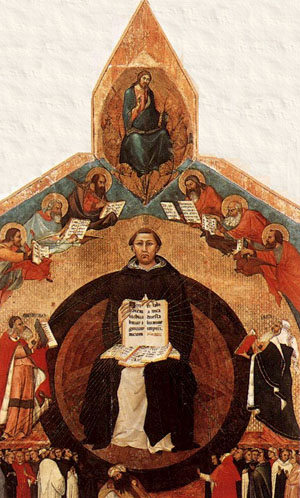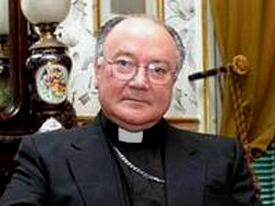 |
Right to Life - Environment
Card. Martino against St. Thomas
on the Death Penalty
Lyle J. Arnold, Jr.
In the 13th century, Pope Gregory IX reprimanded certain theologians for crossing "the boundaries fixed by the Fathers” "These men," said the Holy Father, "led away by various and strange doctrines, turn the head into the tail and force the queen to serve the handmaid" (1). By this he meant that theology – the queen – should not serve human science – the servant.

St. Thomas defended the death penalty |
Until Vatican II, it was held throughout the Church that St. Thomas Aquinas, called the greatest of the Scholastics, was the prince of the theologians. After Vatican II, however, Scholasticism was discarded, precisely because it is our finest instrument for precise thought and careful definition (2).
St. Thomas gives very good reasons for us to be in favor of the death penalty. He says:
“The fact that the evil ones, as long as they live, can be corrected from their errors does not prohibit that they may be justly executed, for the danger which threatens from their way of life is greater and more certain than the good which may be expected from their improvement.
“They also have at that critical point of death the opportunity to be converted to God through repentance. And if they are so obstinate that even at the point of death their heart does not draw back from malice, it is possible to make a quite probable judgment that they would never come away from evil” (3).
However, the progressivists following their leaders "abandoned scholastic language for the sake of what they call `pastoral language,' (a language) so ambiguous and muddy that it tells the sheep to go north and south at the same time" (4). They applied this to the death penalty, casting off the sound arguments of St. Thomas, and pretending it was a matter of human rights and human dignity to oppose it.

Martino: death penalty is "a scandal for the human family in the 21st century" |
A recent example of this comes from the president of the Pontifical Council for Justice and Peace. In late October, Cardinal Renato Martino met with the president of the "International Federation of Action by Christians for the Abolition of Torture” (IFACAT). After the meeting, Martino stated, "Christians are called to defend human rights, and particularly to work for the abolition of the death penalty” (5).
According to Martino, the death penalty is included in the abuses of human rights, which "are grave crimes against the human person, created in the image of God, and a scandal for the human family in the 21st century" (6).
Martino does not give any valid reason; he did not prove that the death penalty is an abuse, nor that it is a scandal. He simply and straightforwardly denies the teaching of St. Thomas Aquinas.
Three examples
Confirming the doctrine set out by St. Thomas Aquinas regarding the possibility of converting a criminal condemned to death, let me give three examples of how the death penalty is just.
1. In 1959 a 19-year-old killed a police officer, and was sentenced to die at San Quentin. I was a Correctional Officer at San Quentin at the time, and was assigned to his execution. There were two Jesuits at the execution, and afterwards I was able to speak with them. One of them had heard the young man's confession. I asked the priest if the convicted man was ready to die. He smiled warmly and said he was. An article appeared shortly after this in a major newspaper, written by the superior of the slain officer. In the article he marveled at the disposition of the penitent at the time of death (7). St. Thomas was right.

Richard Speck, arrogant and unrepentent |
2. In poignant contrast to this story is another one that happened a few years afterwards. In 1966 Richard Speck, in an inhuman orgy of rape and sodomy, murdered eight student nurses in Chicago. He was sentenced to death, but in 1972 the U.S. Supreme Court found the death penalty to be unconstitutional (8). This case became famous and in 1996 a documentary film was made that in part dealt with Speck's life in prison (9). It showed explicit scenes of sex, drug-use, and money being passed around by prisoners who appeared to have no fear of being caught. In the center was Speck, ingesting cocaine, parading around in silk panties, sporting female-like breasts grown from smuggled hormone treatments, and boasting, “If they only knew how much fun I was having, they'd turn me loose"
Speck died of natural causes in 1991, that is, 25 years after his horrendous crimes. I heard nothing about any repentance. Another confirmation of St. Thomas’ doctrine.
3. Let me cite another example taken from the memories of St. Therese of Lisieux. On August 31, 1887, The New York Times ran an article on page five announcing the conversion of the notorious murderer: "Execution of Pranzini; the murderer of Mme. Regnault expiates his crime.” (10). St. Therese, then Marie-Francoise-Therese Martin was 14-years-old at the time. She had prayed and sacrificed with the intention that the unrepentant Pranzini would convert. She had begged God to be shown a sign that the conversion had actually taken place.
In her Autobiography, she reports: "He had mounted the scaffold and was preparing to place his head in the formidable opening, when suddenly, seized by an inspiration, he turned, took hold of the crucifix the priest was holding out to him, and kissed the sacred wounds three times! Then his soul went to receive the merciful sentence of Him who declares that in heaven there will be more joy over one sinner who does penance than over ninety-nine just who have no need of repentance" (11).
Like the Jesuit who heard the condemned man's confession at San Quentin, Therese Martin, soon to be St. Therese of Lisieux, understood that the most important thing was the criminal should repent and die well so as to be received in the Kingdom of God.
I wish that Cardinal Martino would leave aside the hype of political correctness – that pagan and revolutionary talk of human rights – and concentrate on some sound Thomistic philosophy instead. Perhaps he would then re-discover that the soul is more important than the body.
1. Epist. Ad Magistros theol. Paris, July 7, 1223.
2 .John Vennari, "Vatican II vs. Unity Willed by Jesus Christ," www.sspxseminary.org/apologetics/crisis/vatican_Il/unity.html
3. Summa contra gentiles, Book III, chapter 146; St. Thomas on the Death Penalty, TIA website.
4. J. Vennari, "Vatican II vs. Unity .”
5. "Cardinal: Christians Called to Fight Torture." Zenit, Oct. 31, 2006
7. Lyle J. Arnold, Jr., In Favor of the Death Penalty – An Eyewitness to Alexander Robillard's Execution, TIA website, 1-6-07.
8. Dennis L. Breo and William J. Martin, The Crime of the Century – Richard Speck and the Murder of Eight Student Nurses, Bantam Bks/Ny, 1993.
9. The Secret Tapes of Richard Speck, produced by Kurtis Productions, Ltd., in association with A&E Network, NY.
10. Miriam Hogan, "St. Therese: Formative Relationships," carmelitesofeldridge.org.
11. Story of a Soul – The Autobiography of St. Therese of Lisieux, ICS Pub/Wn. D.C., 1972, p. 100.

Posted November 29, 2007

Related Topics of Interest
 St. Thomas on the Death Penalty St. Thomas on the Death Penalty
 Popes on the Death Penalty Popes on the Death Penalty
 In Favor of the Death Penalty – An Eyewitness to an Execution In Favor of the Death Penalty – An Eyewitness to an Execution
 The Common Good and the Criminal The Common Good and the Criminal
 Homosexual Priests Deserve Death Homosexual Priests Deserve Death
 The Popes Must Be Militant Guardians of the Flock The Popes Must Be Militant Guardians of the Flock

|
Right to Life | Cultural | Hot Topics | Home | Books | CDs | Search | Contact Us | Donate

© 2002- Tradition in Action, Inc. All Rights Reserved
|
 |

|